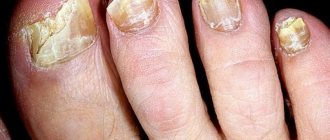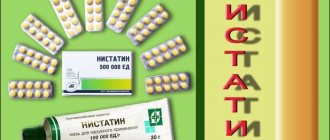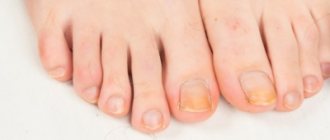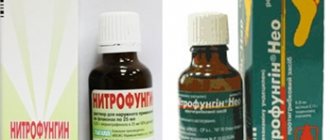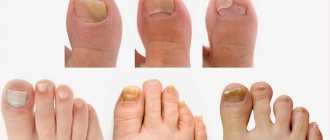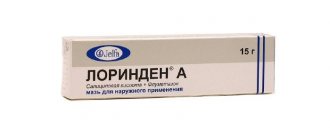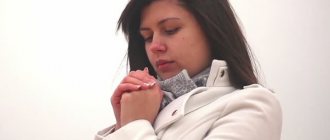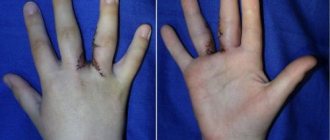Fingernail fungus: photos, symptoms and treatment regimen Most often, fingernail fungus affects people who lead a healthy lifestyle and adhere to it. No matter how paradoxical it may sound, the causes of the disease are often saunas, swimming pools and beaches, where the infection is found in large quantities.
Of course, you can get rid of this disease by resorting to the use of medications, but it will not hurt to use the advice of traditional medicine at home.
Causes
Fungi are ubiquitous in the external environment. They love moisture and warmth. Almost all organs and systems of the human body are affected, including fingernails. Human hands are a unique tool created by nature itself. They are constantly in contact with many objects, and therefore are significantly exposed to environmental factors, including microbial ones. Fingernail fungus does not always develop upon contact with a pathogen. Good immunity and personal hygiene protect a person from this disease.
The main part of onychomycosis is caused by a fungus of the species Trichophyton rubrum (red trichophyton). Much less frequently, the source of the disease is fungi of the species Trichophyton interdigitale, Epidermophyton floccosum, Microsporum, Aspergillus and Candida albicans.
Red trichophyton spreads throughout the body through the blood and lymphatic tract. This is evidenced by damage to the nail from the posterior area (proximally) and the detection of the pathogen in the lymph nodes of the groin area and the secretion of the prostate gland. This form of onychomycosis is rare. The disease is often registered in HIV-infected people.
Who treats onychomycosis?
Which doctor treats nail fungus, who should I contact? A sick person should go to the office of a dermatologist, who is the one who treats skin problems. As soon as the first signs of onychomycosis appear, it is necessary to take countermeasures and get rid of nail fungus. How does nail fungus start? With changes in the appearance of the stratum corneum of the plate.
At first these are small spots that do not disappear, but increase in size. There may not be many of them. Women try to get rid of them with a manicure - they cover the plates with varnish. However, varnish cannot cure nail fungus, but only contributes to the spread of infection. But don’t despair, there are special antifungal varnishes, which you can read about in this article.
Is fingernail fungus contagious? The infection can affect adjacent areas of the skin, and can also be transmitted through household items to other people. Is there an effective treatment for fingernail fungus, and how to get rid of fingernail fungus forever? Treatment for onychomycosis is prescribed by the doctor.
Before choosing drug therapy, a sick person must undergo appropriate tests (scraping from the stratum corneum), on the basis of which an accurate diagnosis can be made.
The therapeutic course consists of:
- taking medications orally, as microbial spores penetrate the body;
- local treatment with gels, ointments, creams and solutions;
- the use of traditional medicine under the guidance of a dermatologist.
Important! You can quickly cure fingernail fungus at the very beginning of the spores entering the body. In this case, medicinal infusions from herbs and plants, as well as special medicinal varnishes, will help.
How to treat fingernail fungus with medications? The course of therapy is determined by the doctor, however, along with taking antifungal drugs, it is also necessary to take protectors - they protect the internal organs from the side effects of the drugs.
If the nail fungus on the finger - thumb or other - has affected more than 60% of the surface of the stratum corneum, hardware cleaning is carried out. Using a special tool, the affected stratum corneum is removed, after softening the rough tissue. Removing part of the plate allows the medications to be absorbed more actively, and the healing process proceeds at a faster pace.
Classification
Modern medicine identifies three main types of fungal nail diseases:
| Onycholytic | characterized by the following signs: the nail plate loses its smoothness and shine, turns gray; lag of the nail from the bed develops quickly; if the nail separates completely, a loose bed is exposed. |
| Normotrophic | manifested by a change in the color of the nail plate from milky white to a grayish-yellow hue. Streaks and spots also form. |
| Hypertrophic | with this form of the disease, the edge of the nail crumbles, the color of the plate turns pale and dull, and the nail plate noticeably thickens. There are pronounced pain sensations. |
Each type of fungal infection can occur differently, resulting in the following diseases:
| Onychomycosis | It affects the periungual ridges and entire nails. Transmitted by infectious means - from a sick person. In this case, one touch or even trying on a glove in a store is enough. Less commonly, the disease develops after contact with a fungus that has multiplied on any fruit; |
| Candidiasis | The fungus that causes this disease constantly lives in the human body. The disease can be triggered by vitamin deficiency, taking antimicrobial drugs, bad eating habits, constant injury to the nails, and frequent and prolonged exposure to high humidity. In this case, not only the nail plates are affected, but also the periungual ridges. Housewives, mothers of small children, food industry workers, etc. are at risk; |
| Dermatophytosis | This word combines several little-studied diseases. The reasons for their occurrence have not yet been clarified. Their treatment is based on the results of laboratory diagnostics. |
| Sporotrichosis | Animal lovers and all persons who frequently come into contact with animals are susceptible. Infection occurs due to fungal spores entering microcracks in the skin. Occupational disease of veterinarians. |
Stages and types of fungal diseases on the hands
Depending on the nature of origin, form of the disease and microbes causing mycosis, the following types of fungus :
- Onychomycosis. A particularly common fungal nail disease. It is characterized by the rapid development and acute course of the disease. This fungus is very dangerous, because it is practically always around people - these are mold spores on fruits, walls, and other surfaces. Infection occurs unusually after contact with an infected object and spores entering microcracks;
- Sporotrichosis. More often than not, children, gardeners and veterinarians who do not follow the rules for examining animals become infected. Its causative agent is sporotrichum particles. The course of the disease can be described as acute. The periungual space of the nails is the first to be affected; in the future, the subcutaneous tissue may be affected;
- Onycholysis – complete detachment of the plate from the skin. This type of mycosis is very dangerous due to the likelihood of damage to young skin. Progresses quickly and is highly contagious. Moreover, its incubation period is 1 week;
- Candidiasis. The reason for its appearance lies in the wrong lifestyle. Candida is a saprophyte, one that is continuously present in the body. Under the influence of certain external factors (abuse of sugary foods, continuous nail injuries, lack of vitamins), the number of these microbes grows exponentially. As a result, tissues begin to change their color, slow down growth and regenerative processes.
According to the form of the disease and severity, the following types of fungi :
- Normotrophic. Mild development of the disease At first, the color of the nail changes slightly, then stripes and spots appear on its surface, and in the future, tissue delamination and thinning begin;
- Hypertrophic. With this type of fungus, the nail is very painful and causes continuous discomfort due to crumbling and brittleness. Separate parts of the plate can dig into the periungual space, provoking the formation of ingrowth in the future;
- Atrophic. Preface of the disease is characterized by thinning of the plate, increased sensitivity of the fingers, and their fragility. In the future, detachment of the plate at the base occurs, and inflammatory processes in the affected tissues occur.
At the same time, it is important to understand that fungal infection of tissues can appear not only due to contact with moldy products or household items.
The main reasons why fungus appears on the nails:
- Improper care. Frequent use of inexpensive varnishes, ignoring safety equipment when working with household chemicals, etc. All these factors make the fabric much thinner;
- Permanent injuries;
- Unsanitary conditions during manicure and pedicure. During the process of nail extension, formation, and coloring, a fungal infection can be introduced onto the surface of the plate. To avoid this, it is important to use the services of only proven salons, where instruments are scrupulously disinfected.
Symptoms
Any type of fingernail fungus (see photo) has 3 main symptoms:
- Change in color of the nail plate;
- Thickening of the nail plate;
- Destruction of the nail in the form of pitted contours and other manifestations.
Changes in nails can begin from the edge of the nail plate or from its base. It depends on the type of microorganism that caused the disease, i.e. whether we are talking about candidiasis or dermatophycosis infection.
The main symptoms of fingernail fungus are as follows:
- The nail changes its color to one degree or another, depending on the type of pathogen. Most often this occurs with total dystrophy.
- The surface of the nail becomes rough. Roughness can be determined both visually and by palpation.
- Nail separation most often occurs with distal-lateral lesions. As the disease progresses, the area of dissection increases.
- The appearance of white spots under the nail.
- Loss of healthy shine. This happens gradually; perhaps for a long time no other manifestations of mcotic lesions will be observed.
- Increased burr formation. This symptom is observed when the skin fold is damaged, when the skin along the edge of the nail begins to quickly die and burst.
- Detachment of the entire nail plate. This symptom is characteristic of total dystrophy.
- Peeling of the skin of the hands. Sometimes fungi affect not only the nails, but also the skin of the hands and it begins to peel off in the form of small scales.
- The appearance of crumbs on the surface of the nail plate. This symptom can be observed with a white superficial form of fungal infection. Subsequently, small depressions form on the surface of the nail.
The advanced stage is most often accompanied by loss of the nail; it becomes loose, the plate thickens and the peeling process occurs, as a result of which the nail lags behind the bed and breaks. At this stage, signs of burning and itching are also characteristic. [adsen]
Symptoms by type
| Form of fungal infection | Symptoms |
| Normotrophic |
|
| Hypertrophic |
|
| Onycholytic |
|
| Atrophic |
|
What is the danger?
Onychomycosis must be treated, since this disease will not go away on its own. The disease will progress, leading to destruction of the nail and infection of the skin around it.
Advanced onychomycosis causes severe discomfort to the patient because he experiences burning, itching, stress, and insomnia. Damage to the integrity of the skin by a fungus leads to the penetration of another infection into the body and the proliferation of pathogenic bacteria in the wound, and the occurrence of other diseases.
What does onychomycosis look like at different stages?
The fungus is divided into 2 stages according to the degree of damage to the nail plate:
Spread of nail fungus on fabric
- initial stage;
- middle stage;
- severe (advanced) stage.
At the first stage, damage is observed in the central part of the nail or on the sides. The area of color change is about a fifth of the nail.
At the second stage, damage to the nail plate ranges from 30%, and not only a change in color occurs, but also in thickness and structure.
The last stage is also called dystrophic. With it, the entire nail plate is affected, it begins to peel, break, become thinner, or vice versa - it turns into a giant growth, and the nail may fall out of the nail fold. Often accompanied by a bacterial infection, the skin and nail folds become inflamed.
How to treat fingernail fungus?
The fight against onychomycosis is a long process. Only a qualified dermatologist can prescribe effective treatment for fungus. Therapy for onychomycosis is carried out with drugs externally and internally. To treat the initial stage of onychomycosis, special varnishes, ointments, and creams are prescribed, which are available in abundance in the pharmacy.
In advanced forms of the disease, the doctor will prescribe corticosteroids, antifungal drugs, and antibiotics. And in case of extensive damage and destruction of most of the nail, the doctor will prescribe removal of the plate.
How to avoid getting infected with a fungus, preventive measures
In order not to know what fungus is on the nails, under them, on the legs, hands, you should know simple preventive precautions that will help overcome the factor causing bacteria:
- trim, thoroughly wash your legs, nails, feet, allocating enough time to the area between your toes;
- all items purchased to be worn on the body must be made from natural and breathable materials
- do not let your feet, nails, or hands stay wet for too long;
- when buying shoes, you should pay attention to quality, softness, and preferably buy natural ones or made from very good leatherette;
- even without inflammatory processes, periodically use antifungal drugs;
- When visiting public places where there is a large accumulation of fungus (swimming pool, bathhouse, sauna, gym, beach), have your own shoes, preferably rubber ones.
And to summarize, I would like to note that onychomycosis is a curable disease that requires a serious approach, comprehensive treatment and time. But before you start the process, you should not delay going to the doctor!
Varnishes for the treatment of hand fungus
Let's look at how to treat fingernail fungus with varnishes, sprays and tonics.
- Batrafen varnish with ciclopirox is harmful to 58 strains of fungus. They use it for a long time, from 3 to 6 months. Within 1 month, treatment of the diseased nail is carried out 1 r. at 2 pm. From the second month, varnish is applied 2 times. in Week. From the 3rd month until complete recovery, the treatment coverage is created 1 rub. in 30 days.
- Terbix spray with terbinafine. The procedure begins with disinfection of the affected plate with alcohol. The spray is sprayed onto the nail and adjacent skin. Number of procedures – 1 – 2 per day.
- Demicten varnish with polyvinyl acetate. The drug relieves swelling and inflammation and gives a drying effect. Daily application of the product kills the causative agents of onychomycosis and eliminates the unpleasant odor emitted by affected hands.
- Candida lotion. The liquid is rubbed into the plate 1 - 3 times. per day after the inflammatory process subsides.
Use of Pharmaceuticals
During therapy, creams, ointments, patches, tablets, and solutions can be used. It all depends on the degree of neglect of the process. The most common antifungal ointments are:
- Exoderil;
- Atifin;
- Triderm;
- Fundizol, etc.
The remedy for nail fungus is applied to the affected surface of the nail according to the instructions. Therapy continues until complete recovery.
Treatment with varnishes
You can buy a special varnish at the pharmacy. It contains active antifungal elements. They affect pathogenic microflora, preventing its further reproduction, and allow you to quickly and effectively defeat the disease. Among the varnishes there are:
- Nailtain;
- Vicks;
- Lotseryl, etc.
Drugs in this group are suitable not only for the treatment, but also for the prevention of fungus. They can be used without a prescription. The course of therapy lasts until complete recovery. The fungus should be treated under the supervision of a doctor.
Tablets for onychomycosis
In addition to ointments and varnishes, in advanced cases, patients are prescribed tablets. They are part of complex therapy and are selected by the attending physician. Self-administration of drugs in this category is not recommended. Tablets for nail fungus include:
- Onyhon;
- Irunin;
- Fluconazole;
- Ketoconazole, etc.
The duration of treatment is determined by the doctor. The product may have contraindications.
Use of aerosols and solutions
Solutions and aerosols penetrate deeply into the affected nail and act on the causative agent of the disease. Recommended as part of complex therapy. Patients are usually prescribed:
- Fukortsin;
- Exoderil;
- Mikozan;
- Lamisil;
- Thermikon, etc.
These drugs have a minimum of contraindications. They can be purchased at any pharmacy chain. However, before you start taking it, you should consult your doctor.
Application of medicinal plasters
Special plasters help to quickly and painlessly remove the affected plate. One example is Nogtimycin. Before you start using the patch you must:
- steam your nails. To do this, use a hot water bath;
- dry the surface. The patch should not be used on wet nails;
- stick the patch on. To do this, follow the attached instructions.
Usually the patch is left on the nail for several days. After this, it is removed along with the damaged nail. These remedies are effective if the plate is already completely destroyed. If after the first time the desired effect was not achieved, the procedure is repeated.
Medicines for oral administration
In case of serious damage to the nail plate, antifungal tablets and capsules are prescribed. The effectiveness of taking these drugs is high and positive effects from treatment are achieved in 95% of patients.
- Fluconazole. Take a 150 mg capsule once a week. After the restoration of a healthy nail, the pills are stopped.
- Diflucan. The medicine is prescribed to eliminate fungus and restore the nail. They drink the drug once every 7 days, 0.15 g. Treatment with Diflucan is carried out after the growth of a new, healthy nail.
These drugs have contraindications and side effects. Taking medications has a negative effect on the kidneys, gastrointestinal tract, and liver. The following are often prescribed to combat fungus: fluconazole, lamisil, mycozoral, diflucan, mycosist, orungal, itramikol.
Treatment of subungual fungus
First of all, consult a dermatologist and accurately determine the type of fungus, since treatment regimens differ radically depending on the causative agents of the infection. And also exclude other diseases that have a similar clinical picture (psoriasis, lichen planus, keratoderma, etc.).
Existing treatment methods:
- Local drug therapy (ointments, creams, varnishes, drops for external use): prescribed mainly for the distal-lateral form, when the affected area is insignificant, the shape of the nail is not significantly changed. Suitable at the initial stage of development of the disease, as well as if taking antimycotics orally has contraindications.
- Systemic treatment (ingestion of antifungal drugs). Indications are: damage to the root of the nail plate, pronounced pathological changes in the nail, several types of infectious agents.
- Removal of the nail plate . Indication: complete lack of results from drug therapy due to the development of a bacterial infection with purulent discharge. More details about the method...
- Physiotherapeutic procedures (laser exposure). An alternative to local drug treatment, with fewer contraindications and greater effectiveness.
- Traditional methods are suitable at the stage of the distal-lateral form with a minimal affected area or as preventive measures after treatment to minimize relapses. Read more about traditional methods...
Local treatment is convenient because antifungal agents are applied directly to the affected area. The range of contraindications and side effects for most drugs is insignificant, which allows you to extend the duration of therapy.
Disadvantage of the method: on average, treatment lasts 1-3 months, there is a possibility of relapses. Depending on the type and degree of development of the fungus, it does not always help to cure the infection.
The main preparations for external use are divided into groups:
- Azoles (Clotrimazole, Ketoconazole, Isoconazole) stop the growth and reproduction of fungi at the enzymatic level.
- Allylamines (Terbinafine, Naftifine, Lamisil, Exoderil) have a destructive effect on the cell membrane of the fungus, which leads to its destruction and death of microorganisms.
- Keratolytic drugs (3% salicylic ointment, 10% sulfur ointment) destroy epithelial tissue cells, which are a breeding ground for the fungus, thereby preventing it from developing.
- Hydroxypyridone preparations (Batrafen, Cyclopiroxolamine) interfere with reproduction and growth, which leads to the death of fungi
- Halogen-containing agents (tincture of iodine alcohol 2%) slow down the growth of fungal cells, dry and disinfect.
The cost depends on the chosen product. Popular external creams and ointments Clotrimazole (150 rubles), Terbinafine (150 rubles), Betrafen (450 rubles), Lamisil (550 rubles).
Systemic drug treatment . Tablets are prescribed exclusively by a doctor based on the results of the analysis. Plus – high efficiency of treatment. Disadvantage: high toxicity, serious contraindications and side effects.
Main drugs: Terbinafine (300 rub./14 tablets), Fluconazole (50 rub./1 tablet), Ketoconazole (150 rub./10 tablets), Griseofulvin (350 rub./20 tablets).
Removing the nail plate is not a panacea, since an untreated infection can cause a relapse. An alternative to mechanical nail removal is “dissolution” at home (gradual killing of the nail followed by complete peeling). Use only on the recommendation of a doctor. Popular nail removal products: Nogtivit (RUB 180/15 ml) and Mikospor set with file (RUB 1,550).
Laser removal of fungus is carried out in a course, on average 5 procedures are required (1 procedure once a week). Effective in combination with the use of immunomodulators and antimycotic agents. The average cost of 1 procedure is 1500 rubles.
Traditional methods
The most popular means:
- tea tree oil;
- tincture of celandine;
- alcohol tincture of garlic;
- alcohol tincture of iodine;
- hydrogen peroxide.
It is recommended to rub into sore nails and also add to baths.
Traditional recipes can be effective in the initial stages of onychomycosis, but more often they are the reason for untimely consultation with a doctor and the transition of the disease to an advanced stage.
Doctors on the diagnosis and treatment of onychomycosis:
Laser and hardware treatment
Hardware cleaning of the nail for fungal diseases allows you to remove the affected layers of the plate, thereby facilitating access for medications to the place of greatest concentration of fungi. Of the hardware methods, the most effective is laser cleaning. This is a completely painless procedure that can reduce the treatment period for fungal nail infections by 1.5-2 times.
In addition to removing the stratum corneum affected by the fungus, the laser kills the fungus itself and its spores, sterilizes the bed, and affects the blood. The symptomatic effect of the laser is also noticeable: drying, desensitization, relieving itching and inflammation. One therapy session lasts up to half an hour, a total of 3-4 may be needed, but after the first procedure the patient notices the effect.
Diseases with similar symptoms
Signs of nail fungus can easily be confused with other ailments on the hands. Among infections, the fungal variety occurs only in half of the cases. Similar symptoms are typical for:
- Eczema, which is accompanied by the appearance of a gray tint and peeling;
- Psoriasis, loss of natural color, thickening, indentations on the surface of the plate;
- Lichen planus, nails become brittle, covered with grooves, peel off;
- Pachyonychia, thickening, deformation, loss of natural color;
- Norwegian scabies is manifested by thickening and atrophy of the nails.
In addition to the above, similarities with the fungus are observed in Reiter's syndrome and Darier's disease. An extensive list of such diseases makes self-medication especially dangerous and requires special diagnostics in a clinical setting.
Folk remedies for treating nail fungus
Time-tested folk remedies can be used at home as a complement to drug treatment for fungus.
- Hydrogen peroxide - applied to a small part of a cotton pad, the size of a nail, applied to the lesion and fixed. Exposure time is 10-15 minutes. The procedure is carried out once a day for 1-3 months. Peroxide, as an active oxidizing agent, has a detrimental effect on the mycelium and spores of fungi;
- Compress of grated potatoes on sore nails. Duration is about half an hour, rinse with warm water.
- Iodine. Apply 1 drop of iodine to sore nails twice a day. There will be a burning sensation during this procedure, but this is normal. Healthy nails are treated with iodine three times a week. The duration of treatment is a month. If the pain during application of this remedy is too severe, then it is worth trying another method of treatment.
- Baths of warm strong coffee. Do it every evening for at least a week. Do not stir up the sediment!
- Soda-salt baths. 1 tbsp. l. Dilute soda and salt into 1 liter of warm water, immerse your fingers with inflamed nails in the bath for 15-20 minutes. Can be taken every day.
- Tea tree oil. Pour 1 teaspoon of shower gel and 10 drops of this product into ½ liter of water. Soak the limbs in the resulting solution for 10-15 minutes daily until the nails heal. Essential oil also works well to get rid of fungus if you rub it into your nails 2 times a day for about 3 months.
- Ointment: 20 g hop cones, 20 g crushed burdock root, 10 g calendula flowers per 1 tbsp. water. Boil in a water bath, strain, mix with Vaseline in a ratio of 1:2. Apply to affected areas several times a day.
- Tar soap - cover the affected nail and roller with this soap, then immerse your hands in salt, wrap your fingers in film, put on gloves or mittens, and leave overnight. You can use this remedy until complete recovery;
- Mint and salt. Grind mint leaves with salt. Apply the resulting paste to the affected nails for 1 hour.
Ideally, folk remedies should be considered as a complement to traditional therapy. They help enhance the effect of antifungal drugs and achieve a speedy cure and eradication (destruction) of fungi.
Conservative treatment methods
To avoid removal of the nail plate, it is recommended to promptly treat the fungus with medications. The easiest way is to apply iodine to areas of pathology as an effective local antiseptic. Additionally, nails are treated with Terbinafine cream; it is important not to forget about observing personal hygiene rules. And there are many such conservative treatment regimens; the presence of antifungal drugs in them in the form of ointments, gels and tablets is mandatory. Below are effective medications for fungus that progresses under the nail.
Antifungal ointments
The therapeutic effect of such medications is local; procedures at home must be performed on previously cleaned foci of pathology up to 3-4 times a day. The duration of intensive therapy is determined individually; ointments are often used for up to 2 - 4 weeks. Here are the most effective medications:
- Terbinafine. This is an external ointment. The active component destroys the membranes of pathogenic fungi, reduces their activity, and removes them from the body. The composition must be applied to the affected areas in the morning and evening. The advantage is a soft action, the disadvantage is a selective effect.
- Undecin. This is an inexpensive ointment based on undecic acid. The active component destroys the structure of pathogenic fungi and inhibits their reproduction. Apply the ointment in a thin layer to a clean surface up to 3-4 times a day. The advantage is quick results, the disadvantage is that it is not suitable for everyone.
Prevention
To prevent fungal infection of the nail plates on the hands and feet, you should follow certain preventive rules.
These include:
- Monitoring the condition of nails with frequent visits to nail salons. For preventive purposes, after a manicure, you can treat your nails with antimycotic cream. However, you shouldn’t get carried away with it often, because... it violates the natural protective layer. It is better to visit a trusted nail salon, where due attention is paid to the measures for processing tools;
- Moderate hand hygiene to preserve the protective lipid layer of the skin, which provides natural antifungal protection;
- Prevention of re-infection is carried out by treating the patient’s gloves, disinfecting nail files, washcloths, and towels. It is advisable to wash the latter at high temperatures and, if possible, iron them.
Prevention of familial infection consists of timely identification and treatment of fungus, especially foot fungus in the elderly, as well as the use of individual towels, nail scissors and other personal hygiene products;
Who is prone to nail fungus infection?
To protect yourself from contact of fungal microorganisms with your skin and nails, you must know the list of risk groups:
- People aged 45 years and older. It is at this age that they are susceptible to a decrease in the immune system and the manifestation of age-related diseases, which gives the “green light” to fungal bacteria;
- Workers in areas where there is frequent contact with water, moisture, dampness and excessive heat (dishwashers, car wash workers, construction workers, cleaners);
- People whose immune system has been affected by the manifestations of diabetes at any stage. In this case, the fungus can penetrate through wounds, inflammations, and skin lesions;
- Children aged 12-17 years. During this period of time, hormonal adjustment of the body occurs, which leads to a decrease in immunity, which means that the body cannot fight infectious manifestations on its own;
- Pregnant women and the lactation period for women are associated with the threat of infection with a fungus, and this is due to interruptions in the body’s hormonal levels;
- People who sweat excessively may contract fungus, especially on the palms and soles of their feet. This is due to the fact that the fungus loves a humid environment, and in these areas of the body there is moisture in the amount required for development;
- Frequent visits to beauty salons for manicure or pedicure care lead to sad consequences. Not every salon adheres to sanitary hygiene standards; not after every patient does the specialist remember to treat the instrument being used, which subsequently results in a large accumulation of pathogenic bacteria.
Etiology of fungal infection of the hands
Fungus on the fingernails appears due to infection by pathogenic microorganisms, or due to increased pathogenic activity of one’s own microflora.
Fact: according to statistics, in 44% of clinical cases the causative agent is yeast-like fungi of the Candida family, followed by parasites of the dermatomycetes group - up to 36% of cases, mold fungi are diagnosed in 16% of all diseases.
The number of fungal infections is increasing every year. This is due to the high survival rate of parasites in unfavorable conditions, as well as the cause of intrafamily infection. If one family member is sick, then the probability of infection of other relatives exceeds 50%.
Definitely, the pathogenesis of the disease is the growth and reproduction of fungal microflora. The following factors lead to the pathological process:
- A disorder of cellular immunity, which is caused by various chronic pathologies - diabetes, HIV, AIDS, etc.
- Long-term use of antibacterial drugs. Glucocorticosteroids, hormonal medications and some other medications provoke fungal activity.
- The use of false nails, under which a favorable environment has been formed for the proliferation of pathogens.
- Frequent contact with water. The risk group includes workers in canteens, public catering establishments, rest homes, sanatoriums, etc. The longer the upper limbs are in a humid environment, the higher the likelihood of getting sick.
- The negative impact of chemicals and alkaline substances weakens the natural protection of the nail plate, which increases the risk of pathology.
- Age-related changes are a factor in fungal infection. Experts note that every 10 years the likelihood of the disease increases several times.
- Mechanical injuries, improper manicure, psychological problems, etc.
In most cases, fungi enter the nail through the nail bed, where they penetrate through small wounds and cracks. If a person has good immunity and no chronic diseases, then the fungus will not develop.
Preventive measures
Simple preventive measures that must be followed every day will help to avoid the disease and prevent relapse:
- personal hygiene requirements;
- using exclusively your own manicure kit;
- use of high-quality cosmetics;
- regular breaks in nail extensions;
- give preference to a trusted manicurist.
After recovery, an obligatory part of prevention is the disinfection of all household items, personal hygiene products, linen and other things.

